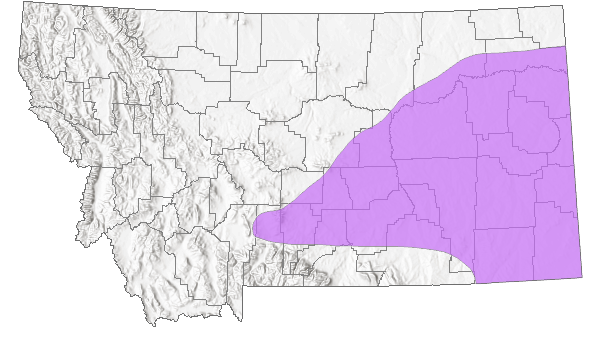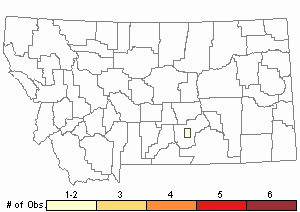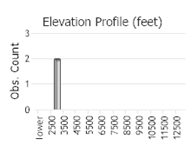View in other NatureServe Network Field Guides
NatureServe
Montana
Utah
Wyoming
Idaho
Wisconsin
British Columbia
South Carolina
Yukon
California
New York
Green Claybank Tiger Beetle - Cicindela denverensis
Native Species
Global Rank:
G4
State Rank:
S4
Agency Status
USFWS:
USFS:
BLM:
External Links
General Description
The following is taken from Carter (1989), Kippenhan (1994), and Pearson et al. (2015). The body length is 12-15 mm. Above is bright green to blue-green, with maculations that are variable but thin and reduced (may be nearly absent). The middle maculation is perpendicular to the outer edge of the elytra but is usually reduced to a transverse dash. Maculations are usually lines although some individuals have more complete maculations. Below is blue to green. Forehead with erect setae, labrum moderately large, mandible with 3 teeth. Referred to as C. purpurea denverensis in some older literature.
Phenology
Tiger beetle life cycles fit two general categories based on adult activity periods. “Spring-fall” beetles emerge as adults in late summer and fall, then overwinter in burrows before emerging again in spring when mature and ready to mate and lay eggs. The life cycle may take 1-4 years. “Summer” beetles emerge as adults in early summer, then mate and lay eggs before dying. The life cycle may take 1-2 years, possibly longer depending on latitude and elevation (Kippenhan 1994, Knisley and Schultz 1997, and Leonard and Bell 1999). Adult Cicindela denverensis, a spring-fall species, emerges from late February through June then July to mid-November, mostly April to May (Larochelle and Larivière 2001, and Pearson et al. 2015); February to June then October in Nebraska (Carter 1989), mid-March to June with stragglers into July, then late August in Colorado (Kippenhan 1994), April to May in South Dakota (Kirk and Balsbaugh 1975), April to August in North Dakota (Kritsky and Smith 2005). In Montana, adults reported early-March to late June then early September (Shincariol 1988, Nate Kohler personal communication, iNaturalist 2023).
Diagnostic Characteristics
The following comes from Carter (1989), Kippenhan (1994), and Pearson et al. (2015). Most similar in the Midwest and Rocky Mountain region to the greenish forms of the
Cow Path Tiger Beetle, (
C. purpurea), however the latter species lacks a humeral maculation (dot) and the middle maculation angles backwards and does not reach the elytra margin. The
Common Claybank Tiger Beetle (
C. limbalis) is bright reddish to reddish-green on the back, not bright green. Recent mtDNA and morphological/ecological studies indicate that the Green Claybank Tiger Beetle,
Common Claybank Tiger Beetle, and the Splendid Tiger Beetle, (
C. splendida) may be a single, quite variable species (Woodcock and Knisley 2009, and Brust et al. 2012a).
Species Range
Montana Range
Range Descriptions

 Native
Native
Range Comments
Cicindela denverensis is present in the prairie region of the western Great Plains east of the Rocky Mountains, from central Montana and the western Dakotas south to northeastern New Mexico, western Oklahoma, and northern Texas (Pearson et al. 2015). In Montana, it has been documented from Gallatin County east through Yellowstone and Petroleum counties to northeastern Wyoming and the Dakotas (Shincariol 1988, iNaturalist 2023) east to the state lines with the Dakotas and northeastern Wyoming.
Observations in Montana Natural Heritage Program Database
Number of Observations: 2
(Click on the following maps and charts to see full sized version)
Map Help and Descriptions
Relative Density

Recency



 (Observations spanning multiple months or years are excluded from time charts)
(Observations spanning multiple months or years are excluded from time charts)
Migration
Non-migratory but capable of dispersal. When wings fully developed (macropterous), it is an excellent flier and fast runner (Larochelle and Larivière 2001).
Habitat
Adult and larval tiger beetle habitat is essentially identical, the larvae live in soil burrows (Knisley and Schultz 1997). Across the range Cicindela denverensis is usually found in prairie regions on steep slopes and barren clay banks, eroded gullies, dry drainage ditches, mudflats, sides of barren bluffs, dunes, road cuts, typically where vegetation is sparse and usually not associated with loose soil (Carter 1989, Kippenhan 1994, Larochelle and Larivière 2001, Kritsky and Smith 2005, and Pearson et al. 2015). In Montana, habitat is poorly described but includes trails along streams, to at least 3300 ft (1005 m) elevation (Nate Kohler personal communication, iNaturalist 2023).
Food Habits
Larval and adult tiger beetles are predaceous. In general, both feed considerably on ants (Wallis 1961, and Knisley and Schultz 1997). The diet of adult Cicindela denverensis in captivity includes mealworms (tenebrionid larvae), other insects, small earthworms. Larvae in captivity fed on termites (Larochelle and Larivière 2001, and Brust et al. 2012b).
Ecology
Larval tiger beetles live in burrows and molt through three instars to pupation, which also occurs in the larval burrow. Adults make shallow burrows in soil for overnight protection, deeper burrows for overwintering. Adults are sensitive to heat and light and most active during sunny conditions. Excessive heat during midday on sunny days drives adults to seek shelter among vegetation or in burrows (Wallis 1961, and Knisley and Schultz 1997).
Cicindela denverensis has a narrow range of ecological tolerance (stenotopic). Adults are diurnal and gregarious. Larvae survive immersion in hypoxic water up to 140 hours, adults up to 15 hours (Brust and Hoback 2009). Predators are not described but probably include birds and asilid (robber) flies. Other associated tiger beetle species include,
C. decemnotata,
C. duodecimguttata,
C. formosa,
C. fulgida,
C. limbalis,
C. nebraskana,
C. purpurea,
C. repanda,
C. scutellaris,
C. splendida,
C. tranquebarica (Kippenhan 1994, Larochelle and Larivière 2001, Kritsky and Smith 2005, and Brust et al. 2012a).
Reproductive Characteristics
The life cycle of
Cicindela denverensis is probably 2-3 years but not described (Pearson et al. 2015). Mating is in May. Adult females oviposit during the day near the surface (7-9 mm) or by digging (to depths of 20-60 mm). Fresh adults (tenerals) emerge in late fall but do not mate, then overwinter and reach sexual maturity the following spring. Larvae are not described. Interspecific copulations reported with
C. splendida, hybrids reported in central Nebraska with
C. limbalis and
C. splendida (Larochelle and Larivière 2001, Brust et al. 2012a, 2012b). No information for Montana.
Management
Not considered rare or in need of special conservation management (Knisley et al. 2014). C. denverensis benefits from anthropogenic creation and maintenance of clay roads, paths, and powerline corridors, although vehicle/bicycle use of roads and paths could negatively impact some local populations. Exotic grasses, such as cheatgrass, could become a problem at local scales where they invade moist and open disturbed habitats. Larval burrows could be impacted by trampling through livestock overgrazing or concentrations near water sources, but grazing at appropriate times and stocking levels could also be beneficial by keeping vegetation cover more open (Knisley 2011).
References
- Literature Cited AboveLegend:
 View Online Publication
View Online Publication Brust, M.L. and W.W. Hoback. 2009. Hypoxia tolerance in adult and larval Cicindela tiger beetles varies by life history but not habitat association. Annals of the Entomological Society of America 102(3):462-466.
Brust, M.L. and W.W. Hoback. 2009. Hypoxia tolerance in adult and larval Cicindela tiger beetles varies by life history but not habitat association. Annals of the Entomological Society of America 102(3):462-466. Brust, M.L., C.B. Knisley, S.M. Spomer, and K. Miwa. 2012b. Observations of oviposition behavior among North American tiger beetle (Coleoptera: Carabidae: Cicindelinae) species and notes on mass rearing. The Coleopterists Bulletin 66(4):309-314.
Brust, M.L., C.B. Knisley, S.M. Spomer, and K. Miwa. 2012b. Observations of oviposition behavior among North American tiger beetle (Coleoptera: Carabidae: Cicindelinae) species and notes on mass rearing. The Coleopterists Bulletin 66(4):309-314. Brust, M.L., W.W. Hoback, and S.M. Spomer. 2012a. Splendid hybrids: the effects of a tiger beetle hybrid zone on apparent species diversity. Psyche 2012:1-10. doi:10.1155/2012/398180
Brust, M.L., W.W. Hoback, and S.M. Spomer. 2012a. Splendid hybrids: the effects of a tiger beetle hybrid zone on apparent species diversity. Psyche 2012:1-10. doi:10.1155/2012/398180 Carter, M. R. 1989. The biology and ecology of the tiger beetles (Coleoptera: Cicindelidae) of Nebraska. Transactions of the Nebraska Academy of Sciences XVII: 1-18.
Carter, M. R. 1989. The biology and ecology of the tiger beetles (Coleoptera: Cicindelidae) of Nebraska. Transactions of the Nebraska Academy of Sciences XVII: 1-18. iNaturalist. Research-grade Observations. Accessed 5 November 2023. https://www.inaturalist.org/
iNaturalist. Research-grade Observations. Accessed 5 November 2023. https://www.inaturalist.org/ Kippenhan, Michael G. 1994. The Tiger Beetles (Coleoptera: Cicindelidae) of Colorado. 1994. Transactions of the American Entomological Society 120(1):1-86.
Kippenhan, Michael G. 1994. The Tiger Beetles (Coleoptera: Cicindelidae) of Colorado. 1994. Transactions of the American Entomological Society 120(1):1-86. Kirk, V.M. and E.U. Balsbaugh, Jr. 1975. A list of beetles of South Dakota. Brookings, SD: South Dakota State University. Agricultural Experiment Station, Technical Bulletin 42. 139 pages.
Kirk, V.M. and E.U. Balsbaugh, Jr. 1975. A list of beetles of South Dakota. Brookings, SD: South Dakota State University. Agricultural Experiment Station, Technical Bulletin 42. 139 pages. Knisley, C.B. 2011. Anthropogenic disturbances and rare tiger beetle habitats: benefits, risks, and implications for conservation. Terrestrial Arthropod Reviews 4:41-61.
Knisley, C.B. 2011. Anthropogenic disturbances and rare tiger beetle habitats: benefits, risks, and implications for conservation. Terrestrial Arthropod Reviews 4:41-61. Knisley, C.B., and T.D. Schultz. 1997. The biology of tiger beetles and a guide to the species of the south Atlantic states. Virginia Museum of Natural History Special Publication Number 5. 210 p.
Knisley, C.B., and T.D. Schultz. 1997. The biology of tiger beetles and a guide to the species of the south Atlantic states. Virginia Museum of Natural History Special Publication Number 5. 210 p. Knisley, C.B., M. Kippenhan, and D. Brzoska. 2014. Conservation status of United States tiger beetles. Terrestrial Arthropod Reviews 7:93-145.
Knisley, C.B., M. Kippenhan, and D. Brzoska. 2014. Conservation status of United States tiger beetles. Terrestrial Arthropod Reviews 7:93-145. Kohler, Nathan S. Excel spreadsheets of tiger beetle observations. 6 August 2022.
Kohler, Nathan S. Excel spreadsheets of tiger beetle observations. 6 August 2022. Kritsky, G. and J. Smith. 2005. Teddy's tigers: the Cicindelidae (Coleoptera) of Theodore Roosevelt National Park, North Dakota. Cicindela 37(1-2):1-16
Kritsky, G. and J. Smith. 2005. Teddy's tigers: the Cicindelidae (Coleoptera) of Theodore Roosevelt National Park, North Dakota. Cicindela 37(1-2):1-16 Larochelle, A and M Lariviere. 2001. Natural history of the tiger beetles of North America north of Mexico. Cicindela. 33:41-162.
Larochelle, A and M Lariviere. 2001. Natural history of the tiger beetles of North America north of Mexico. Cicindela. 33:41-162. Leonard, Jonathan G. and Ross T. Bell, 1999. Northeastern Tiger Beetles: a field guide to tiger beetles of New England and eastern Canada. Boca Raton, FL: CRC Press. 176 p.
Leonard, Jonathan G. and Ross T. Bell, 1999. Northeastern Tiger Beetles: a field guide to tiger beetles of New England and eastern Canada. Boca Raton, FL: CRC Press. 176 p. Pearson, D.L., C.B. Knisley, D.P. Duran, and C.J. Kazilek. 2015. A field guide to the tiger beetles of the United States and Canada, second edition. New York, NY: Oxford University Press. 251 p.
Pearson, D.L., C.B. Knisley, D.P. Duran, and C.J. Kazilek. 2015. A field guide to the tiger beetles of the United States and Canada, second edition. New York, NY: Oxford University Press. 251 p. Schincariol, L.A. 1988. Mating behaviour, spermatophore structure, ecology and systematics of the Cicindela splendida group (Coleoptera: Cicindelidae). M.Sc. Thesis. Thunder Bay, Ontario: Lakehead University. 236 p.
Schincariol, L.A. 1988. Mating behaviour, spermatophore structure, ecology and systematics of the Cicindela splendida group (Coleoptera: Cicindelidae). M.Sc. Thesis. Thunder Bay, Ontario: Lakehead University. 236 p. Wallis, J.B. 1961. The Cicindelidae of Canada. Toronto, Ontario, Canada: University of Toronto Press. 74 p.
Wallis, J.B. 1961. The Cicindelidae of Canada. Toronto, Ontario, Canada: University of Toronto Press. 74 p. Woodcock, R.M. and C.B. Knisley. 2009. Genetic analysis of an unusual population of the problematic tiger beetle group, Cicindella spendida/C. limbalis, from Virginia, U.S.A. (Coleoptera: Cicindellidae) using mtDNA. Entomological News 120(4):341-348.
Woodcock, R.M. and C.B. Knisley. 2009. Genetic analysis of an unusual population of the problematic tiger beetle group, Cicindella spendida/C. limbalis, from Virginia, U.S.A. (Coleoptera: Cicindellidae) using mtDNA. Entomological News 120(4):341-348.
- Additional ReferencesLegend:
 View Online Publication
View Online Publication
Do you know of a citation we're missing? Bousquet, Yves. 2012. Catalogue of Geadephaga (Coleoptera; Adephaga) of America north of Mexico. ZooKeys. 245:1-1722.
Bousquet, Yves. 2012. Catalogue of Geadephaga (Coleoptera; Adephaga) of America north of Mexico. ZooKeys. 245:1-1722. Pearson, D.L., C.B. Knisley, and C.J. Kazilek. 2006. A field guide to the tiger beetles of the United States and Canada: identification, natural history, and distribution of the Cicindelidae. Oxford University Press, New York, New York. 227 pp.
Pearson, D.L., C.B. Knisley, and C.J. Kazilek. 2006. A field guide to the tiger beetles of the United States and Canada: identification, natural history, and distribution of the Cicindelidae. Oxford University Press, New York, New York. 227 pp.
- Web Search Engines for Articles on "Green Claybank Tiger Beetle"
- Additional Sources of Information Related to "Insects"





